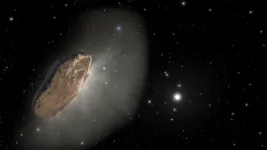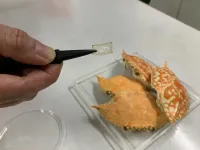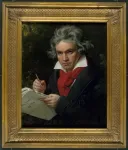(Press-News.org)
Photos // Video
The push toward truly autonomous vehicles has been hindered by the cost and time associated with safety testing, but a new system developed at the University of Michigan shows that artificial intelligence can reduce the testing miles required by 99.99%.
It could kick off a paradigm shift that enables manufacturers to more quickly verify whether their autonomous vehicle technology can save lives and reduce crashes. In a simulated environment, vehicles trained by artificial intelligence perform perilous maneuvers, forcing the AV to make decisions that confront drivers only rarely on the road but are needed to better train the vehicles.
To repeatedly encounter those kinds of situations for data collection, real world test vehicles need to drive for hundreds of millions to hundreds of billions of miles.
"The safety critical events—the accidents, or the near misses—are very rare in the real world, and often time AVs have difficulty handling them," said Henry Liu, U-M professor of civil engineering and director of both Mcity and the Center for Connected and Automated Transportation, a regional transportation research center funded by the U.S. Department of Transportation.
U-M researchers refer to the problem as the "curse of rarity," and they're tackling it by learning from real-world traffic data that contains rare safety-critical events. Testing conducted on test tracks mimicking urban as well as highway driving showed that the AI-trained virtual vehicles can accelerate the testing process by thousands of times. The study appears on the cover of Nature.
"The AV test vehicles we're using are real, but we've created a mixed reality testing environment. The background vehicles are virtual, which allows us to train them to create challenging scenarios that only happen rarely on the road," Liu said.
U-M's team used an approach to train the background vehicles that strips away nonsafety-critical information from the driving data used in the simulation. Basically, it gets rid of the long spans when other drivers and pedestrians behave in responsible, expected ways—but preserves dangerous moments that demand action, such as another driver running a red light.
By using only safety-critical data to train the neural networks that make maneuver decisions, test vehicles can encounter more of those rare events in a shorter amount of time, making testing much cheaper.
"Dense reinforcement learning will unlock the potential of AI for validating the intelligence of safety-critical autonomous systems such as AVs, medical robotics and aerospace systems," said Shuo Feng, assistant professor in the Department of Automation at Tsinghua University and former assistant research scientist at the U-M Transportation Research Institute.
"It also opens the door for accelerated training of safety-critical autonomous systems by leveraging AI-based testing agents, which may create a symbiotic relationship between testing and training, accelerating both fields."
And it's clear that training, along with the time and expense involved, is an impediment. An October Bloomberg article stated that although robotaxi leader Waymo's vehicles had driven 20 million miles over the previous decade, far more data was needed.
"That means," the author wrote, "its cars would have to drive an additional 25 times their total before we’d be able to say, with even a vague sense of certainty, that they cause fewer deaths than bus drivers."
Testing was conducted at Mcity's urban environment in Ann Arbor, as well as the highway test track at the American Center for Mobility in Ypsilanti.
Launched in 2015, Mcity, was the world’s first purpose-built test environment for connected and autonomous vehicles. With new support from the National Science Foundation, outside researchers will soon be able to run remote, mixed reality tests using both the simulation and physical test track, similar to those reported in this study.
Real-world data sets that support Mcity simulations are collected from smart intersections in Ann Arbor and Detroit, with more intersections to be equipped. Each intersection is fitted with privacy-preserving sensors to capture and categorize each road user, identifying its speed and direction. The research was funded by the Center for Connected and Automated Transportation and the National Science Foundation.
Study: Dense reinforcement learning for safety validation of autonomous vehicles (DOI: 10.1038/s41586-023-05732-2) (available when embargo lifts)
END
Simulated terrible drivers cut the time and cost of AV testing by a factor of one thousand
New virtual testing environment breaks the 'curse of rarity' for autonomous vehicle emergency decision-making
2023-03-22
ELSE PRESS RELEASES FROM THIS DATE:
Multiple substance use disorders may share inherited genetic signature
2023-03-22
A new study suggests that a common genetic signature may increase a person’s risk of developing substance use disorders, regardless of whether the addiction is to alcohol, tobacco, cannabis or opioids. The research, led by Washington University School of Medicine in St. Louis, eventually could lead to universal therapies to treat multiple substance use disorders and potentially help people diagnosed with more than one.
Published March 22 in the journal Nature Mental Health, the study’s findings are drawn from an analysis of genomic data from more than 1.1 million people of mostly European ancestry and a smaller ...
How vision begins
2023-03-22
Researchers at the Paul Scherrer Institute PSI have deciphered the molecular processes that first occur in the eye when light hits the retina. The processes – which take only a fraction of a trillionth of a second – are essential for human sight. The study has now been published in the scientific journal Nature.
It only involves a microscopic change of a protein in our retina, and this change occurs within an incredibly small time frame: it is the very first step in our light perception and ability to see. It is also the ...
New NIH study reveals shared genetic markers underlying substance use disorders
2023-03-22
By combing through genomic data of over 1 million people, scientists have identified genes commonly inherited across addiction disorders, regardless of the substance being used. This dataset – one of the largest of its kind – may help reveal new treatment targets across multiple substance use disorders, including for people diagnosed with more than one. The findings also reinforce the role of the dopamine system in addiction, by showing that the combination of genes underlying addiction disorders was also associated with regulation of dopamine signaling.
Published ...
Surprisingly simple explanation for the alien comet 'Oumuamua's weird orbit
2023-03-22
In 2017, a mysterious comet dubbed 'Oumuamua fired the imaginations of scientists and the public alike. It was the first known visitor from outside our solar system, it had no bright coma or dust tail, like most comets, and a peculiar shape — something between a cigar and a pancake — and its small size more befitted an asteroid than a comet.
But the fact that it was accelerating away from the sun in a way that astronomers could not explain perplexed scientists, leading some to suggest that it was an alien spaceship.
Now, a University of California, Berkeley, astrochemist ...
Smaller, denser, better illuminators for computational microscopy
2023-03-22
Seeking to expand the possibilities offered by programmable illumination, a group of researchers at the University of Connecticut developed a strategy for constructing and calibrating freeform illuminators offering greater flexibility for computational microscopy. Their calibration method uses a blood-coated sensor for reconstruction of light source positions. They demonstrated the use of calibrated freeform illuminators for Fourier ptychographic microscopy, 3D tomographic imaging and on-chip microscopy and used a calibrated freeform illuminator in an experiment to track bacterial growth.
The group’s research was published Feb. 20 in Intelligent Computing, a Science ...
Binghamton University reaches highest ever score for LGBTQ+ inclusion
2023-03-22
BINGHAMTON, N.Y. -- Binghamton University, State University of New York scored a nearly perfect ranking on the latest national Campus Pride Index, which measures a university’s commitment to LGBTQ+ safety and inclusivity on campus. The University received a 4.5 out of 5, an increase from the 3.5 scores received in previous years.
Nicholas Martin, assistant director of the LGBTQ Center at Binghamton University, sees this as a reflection of the organization’s dedication and Binghamton’s real commitment to outreach.
“Our ...
Researchers make biodegradable optical components from crab shells
2023-03-22
WASHINGTON — Researchers have developed a process to turn crab shells into a bioplastic that can be used to make optical components known as diffraction gratings. The resulting lightweight, inexpensive gratings are biodegradable and could enable portable spectrometers that are also disposable.
“The Philippines is known for delicious seafood, but this industry is also a source of large amounts of solid waste such as discarded crab shells,” said research team leader Raphael A. Guerrero, from Ateneo de Manila University in the Philippines. “We wanted to find an alternative use for crab shell ...
Beethoven’s genome offers clues to composer’s health and family history
2023-03-22
University of Cambridge Media Release
Beethoven’s genome offers clues to composer’s health and family history
UNDER STRICT EMBARGO UNTIL 11:00 US ET / 15:00 UK / 16:00 CET ON WEDNESDAY 22nd MARCH 2023
International team of scientists deciphers renowned composer’s genome from locks of hair.
Study shows Beethoven was predisposed to liver disease, and infected with Hepatitis B, which – combined with his alcohol consumption – may have contributed to his death.
DNA ...
Ludwig von Beethoven’s genome sheds light on chronic health problems and cause of death
2023-03-22
In 1802, Ludwig van Beethoven asked his brothers to request that his doctor, J.A. Schmidt, describe his malady—his progressive hearing loss—to the world upon his death so that "as far as possible at least the world will be reconciled to me after my death." Now, more than two centuries later, a team of researchers reporting in the journal Current Biology on March 22 have partially fulfilled his wish by analyzing DNA they lifted and pieced together from locks of his hair.
“Our primary goal was to shed light on Beethoven’s health problems, which famously include progressive hearing loss, beginning in his mid- to late-20s and eventually leading to him ...
Unusual Toxoplasma parasite strain killed sea otters and could threaten other marine life
2023-03-22
Scientists in California are raising the alarm about a newly reported form of toxoplasmosis that kills sea otters and could also infect other animals and people. Although toxoplasmosis is common in sea otters and can sometimes be fatal, this unusual strain appears to be capable of rapidly killing healthy adult otters. This rare strain of Toxoplasma hasn’t been detected on the California coast before, and may be a recent arrival, but scientists are concerned that if it contaminates the marine food chain it could potentially pose a public health risk.
“I have studied Toxoplasma infections in sea otters for 25 years — I have never ...
LAST 30 PRESS RELEASES:
Numbers in our sights affect how we perceive space
SIMJ announces global collaborative book project in commemoration of its 75th anniversary
Air pollution exposure and birth weight
Obstructive sleep apnea risk and mental health conditions among older adults
How talking slows eye movements behind the wheel
The Ceramic Society of Japan’s Oxoate Ceramics Research Association launches new international book project
Heart-brain connection: international study reveals the role of the vagus nerve in keeping the heart young
Researchers identify Rb1 as a predictive biomarker for a new therapeutic strategy in some breast cancers
Survey reveals ethical gaps slowing AI adoption in pediatric surgery
Stimulant ADHD medications work differently than thought
AI overestimates how smart people are, according to HSE economists
HSE researchers create genome-wide map of quadruplexes
Scientists boost cell "powerhouses" to burn more calories
Automatic label checking: The missing step in making reliable medical AI
Low daily alcohol intake linked to 50% heightened mouth cancer risk in India
American Meteorological Society announces Rick Spinrad as 2026 President-Elect
Biomass-based carbon capture spotlighted in newly released global climate webinar recording
Illuminating invisible nano pollutants: advanced bioimaging tracks the full journey of emerging nanoscale contaminants in living systems
How does age affect recovery from spinal cord injury?
Novel AI tool offers prognosis for patients with head and neck cancer
Fathers’ microplastic exposure tied to their children’s metabolic problems
Research validates laboratory model for studying high-grade serous ovarian cancer
SIR 2026 delivers transformative breakthroughs in minimally invasive medicine to improve patient care
Stem Cell Reports most downloaded papers of 2025 highlight the breadth and impact of stem cell research
Oxford-led study estimates NHS spends around 3% of its primary and secondary care budget on the health impacts of heat and cold in England
A researcher’s long quest leads to a smart composite breakthrough
Urban wild bees act as “microbial sensors” of city health.
New study finds where you live affects recovery after a hip fracture
Forecasting the impact of fully automated vehicle adoption on US road traffic injuries
Alcohol-related hospitalizations from 2016 to 2022
[Press-News.org] Simulated terrible drivers cut the time and cost of AV testing by a factor of one thousandNew virtual testing environment breaks the 'curse of rarity' for autonomous vehicle emergency decision-making





